- Alaskan Yachts
- Azimut Yachts
- Back Cove Yachts
- Beneteau Yachts
- Benetti Superyachts
- Bertram Yachts
- Boston Whaler
- Broward Yachts
- Buddy Davis Sportfish
- Burger Yachts
- Cabo Yachts
- Catamarans
- Carver Motoryachts
- Center Console
- Chris-Craft Yachts
- Cruisers Yachts
- DeFever Trawlers
- Dufour Sailboats
- Fairline Yachts
- Feadship Yachts
- Ferretti Yachts
- Formula Yachts
- Fountaine Pajot Cats
- Grady-White
- Grand Banks Trawlers
- Hargrave Yachts
- Hatteras Yachts
- Hinckley Picnic Boats
- Horizon Yachts
- Hydra-Sports
- Intrepid Boats
- Jarrett Bay Sportfish
- Jeanneau Yachts
- Kadey-Krogen Trawlers
- Lazzara Yachts
- Luhrs Sportfish
- Marlow Yachts
- Maritimo Yachts
- Marquis Yachts
- McKinna Motoryachts
- Meridian Yachts
- Midnight Express
- MJM Yachts
- Mochi Craft
- Neptunus Motoryachts
- Nordhavn Trawlers
- Nordic Tugs
- Ocean Alexander Yachts
- Offshore Yachts
- Outer Reef
- Oyster Sailing Yachts
- Pacific Mariner Yachts
- Palmer Johnson Yachts
- Pershing Yachts
Bold Statement: Carver C52 Blends Design, Performance
October 27, 2016 7:19 am
The following review appears in Power & Motoryacht magazine.
The C52 Command Bridge, Carver’s latest luxury motoryacht, blends forward-thinking design, comfort, and performance.
“Say again?” I asked, with a certain amount of curiosity in my voice, as I jotted down performance numbers on the new Carver C52 Command Bridge. For just a moment, I had looked away from the speed over ground reading on the Raymarine MFD.
“That’s 22 knots at 2400 rpm, and we’re burning about 18 gph per engine,” said Chris Rugierri, the owner and president of Intrinsic Yacht and Ship in Stevensville, Maryland, just across Chesapeake Bay from Annapolis.
My curiosity sprang from the perception that we were just loafing along, downbound for the Bay in the channel leading to Annapolis Harbor and the Severn River. We had popped up on plane smoothly at about 1700 rpm, and just over 9 knots, in roughly 9 seconds. And now we were on our way up the performance ladder, cranking the twin 600-horsepower Cummins QSC8.3 diesels, which were well muted beneath the aft deck.
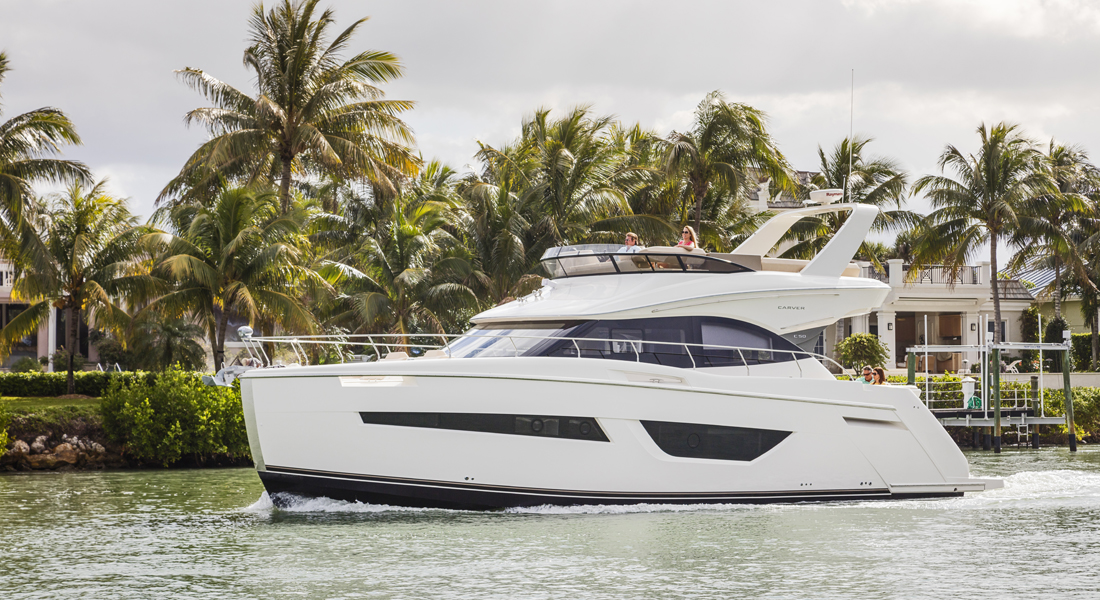
And the efficiency was notable. Between 2400 and 3000 rpm, our speed increased from 22 to 30 knots, while fuel consumption for both motors rose from 37 to 60 gph. In essence, we were ripping along in a 52-foot, nearly 25-ton, luxury motoryacht at distance-chewing speeds I’d never experienced on a Carver before. And we were doing it with the smaller set of two available diesel options.
For those who want more, a pair of optional 715-horsepower Cummins diesels will give it to them. But for my money, the flat nautical-miles-per-gallon figure, which remained in the .58 to .50 range above 2400 rpm, convinced me that the twin 600-horsepower units make a fine balance of economy and speed for those who want to cruise between 20 and 30 knots and still retain the ability to adjust performance according to local wind and wave conditions.
Our test runs were very quiet as well, only registering about 70 decibels on the flybridge and 75 in the saloon at 22 knots. Turns port and starboard through a range of cruising speeds and even at the WOT speed of 31 knots were slightly inboard-banking, with no cavitation from the props in modest tunnels, and always under complete control. And even though we weren’t seeing much more than a 1-foot chop with occasional 2-footers, the spray patterns remained nicely wide of the boat.
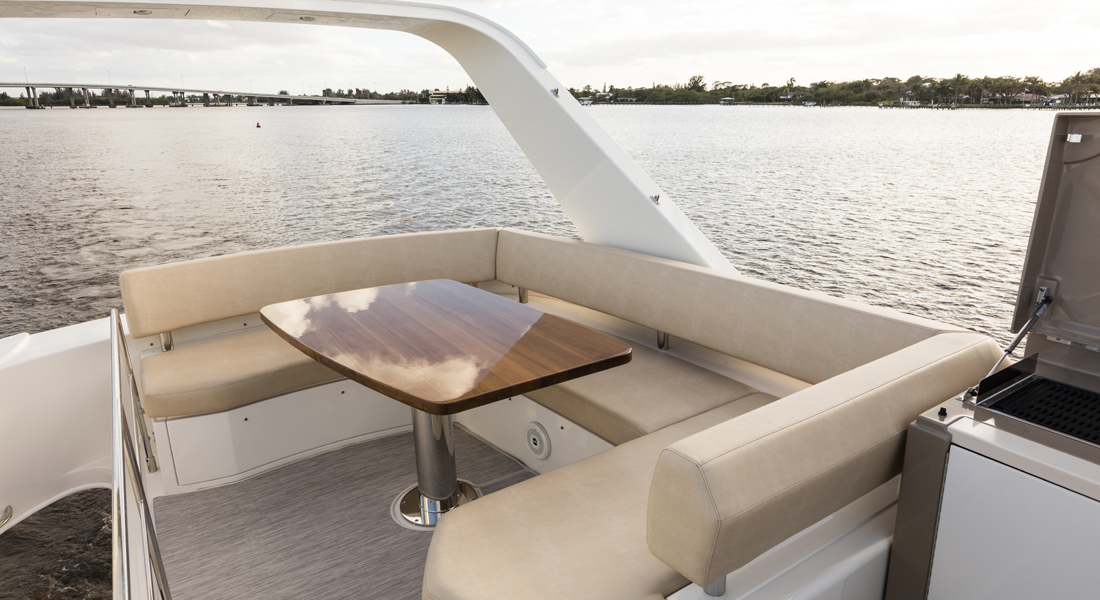
The C52 Command Bridge (and yes, there’s a bridge-less coupe version on the way) is unlike any Carver I’ve ever seen. Her distinctive plumb stem, high topsides, and modestly aerodynamic deckhouse are contemporary without being extreme, and they define a high-volume structure that makes a bold statement about the future direction of Carver in the marketplace.
“We started exploring concepts that would set Carver designs apart from motoryachts of the past, as well as everything else on the market, in 2011,” said Josh Delforge, vice president of design and engineering for Carver. “Paul Miller, our internal designer, drew new lines in our search for the next look for Carver, and they were unique for this company, real head-turners.”
Essentially, everyone involved knew that the new design had to be a departure from the old Carver look. There was nothing wrong with the older models, which were well built and comfortable. But new product development dollars are tough to come by, so they decided to make an impact, and catch some attention.
The plumb bow was not only unique, aggressive, and substantial looking, it also found favor with existing customers as well as with those who were in the up-and-coming younger customer base. Everyone was excited about the new concept, so Carver committed to the first two designs, a 34- and a 37-footer. The plumb bow and raised sheer, as it developed, also offered far more volume forward for accommodations. Customer praise for the larger spaces forward in both the C34 and the C37 were unanimous.
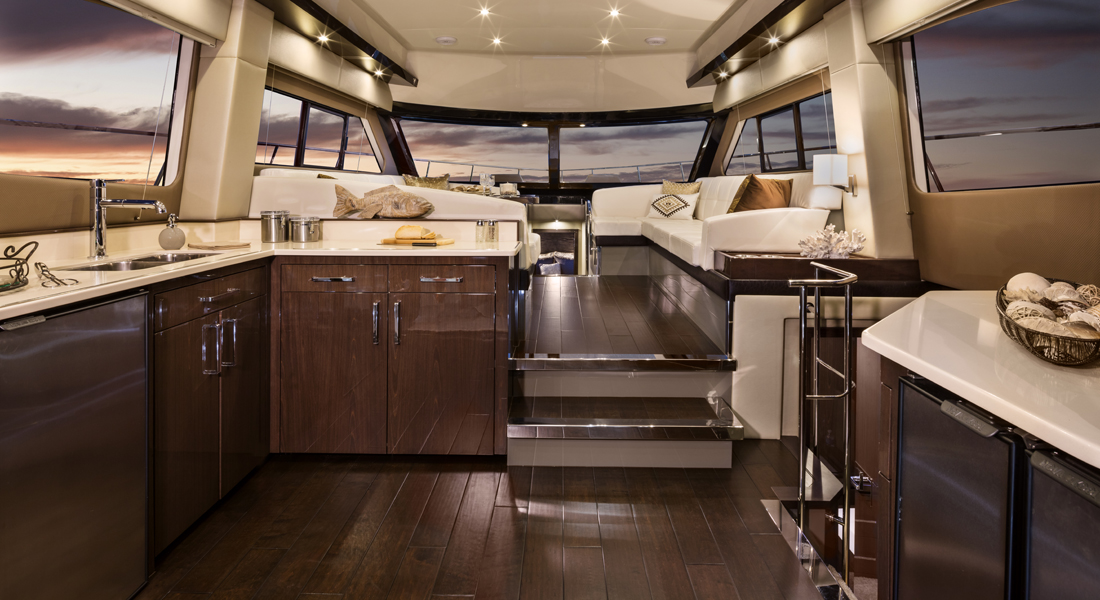
The C52 I tested also seemed to have the interior space of a 55-foot or larger yacht. Beginning with the smaller, 34-foot design may have been the hardest place to introduce the concept. To my eye, the new C52 has nicely balanced lines, and beautiful proportions.
All three new models were developed from the keel up, keeping in mind that Carvers have been known as beamy and stable, as well as for having a lot of living space and stowage.
“We leveraged new technologies in hull design that allowed us to merge historical performance data from hulls we liked and to blend it into the new concept,” Delforge said. “This let us optimize the hull shape—using the best combination of chine width and shape, deep-V forward, and flatter planing sections aft, tunnel depth and shape, and placement—to improve the ride quality over a range of speeds and water conditions.”
To achieve its performance goals, Carver needed to get weight out of the structure, enabling the use of smaller engines for efficient performance, and improving the affordability of the design. Vacuum-assisted resin infusion proved to be the best way to get weight out of the structure, using coring throughout for a quieter ride and greater strength.
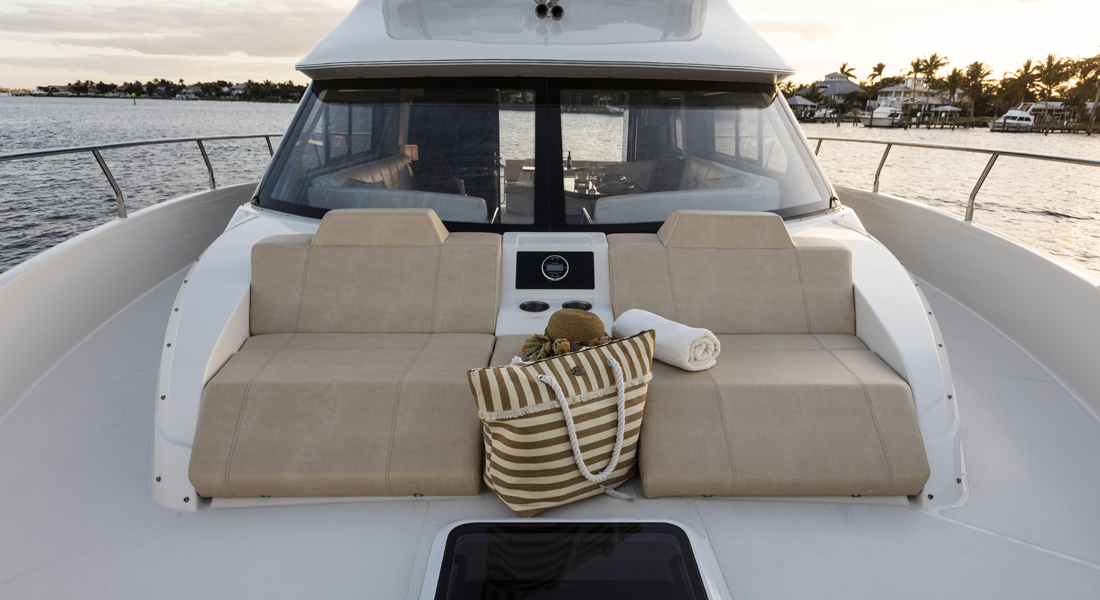
Hull bottoms are cored with end-grain balsa that’s completely encapsulated in resin to prevent water damage—an advance made possible by the resin-infusion process. All through-hull components are segregated by solid fiberglass. Decks are not resin-infused because of the complexity of their shapes, but most every other structure uses this process.
The structural grid adding rigidity to the hull has multiple transverse stiffeners running from chine to chine, with four full-length longitudinals along the bottom of the boat that run right up into the bow. Additional hullside stiffeners add more support to flat panels. The stringer grid is laminated with multiple layers of fiberglass in sections, mitigating the need for wood as support. There’s extra fiberglass in way of the engines, generator, and drive gear for extra rigidity and strength.
“We work with the staff at Donald J. Blount and Associates, naval architects, and have for a number of years, to help ensure the best possible, most efficient structures,” Delforge said. “We send them our drawings of the 3-D model, stringers, bulkheads, performance projections and everything in the yacht, and they analyze it all to meet CE and other requirements, and to make recommendations right down to the need for adding or eliminating specific fiberglass laminate requirements, bulkhead construction, major component placement, even the size and shape of tunnels, to keep draft to a minimum.”
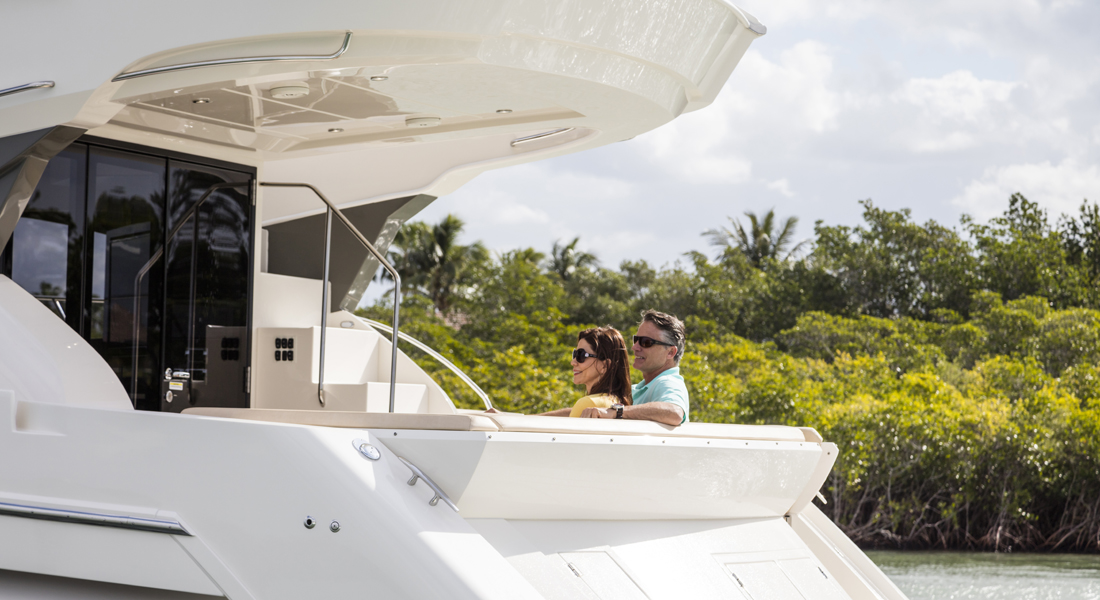
One interesting recommendation involved the swim platform. On the first couple of hulls, which had an LOA of 49 feet, 10 inches, the fixed platform was relatively small, but optioning a larger hydraulic platform added 2 more feet. In the final analysis, the fixed swim platform, which is now the same size as the component used on the hydraulic version, was deemed standard.
“Now it’s far more robust, and will accept the addition of hydraulics and the weight of a tender more efficiently,” Delforge said. “All of the necessary structure is already in place at the transom on every yacht, so there’s no need for major modifications or reinforcement if an owner decides to add the hydraulic platform at a later date.”
There’s a massive sunpad on the foredeck with comfortable, chaise-like seating. Getting to the foredeck safely is paramount, whether for relaxing or for handling anchor or dockline duties, so Carver included higher-than-usual bulwarks, with plenty of stainless steel handrails on both sides, including a pair on either side, to grab when boarding via the high sides of the aft deck, and a separate pair to steady you going up and down the molded steps to the side decks.
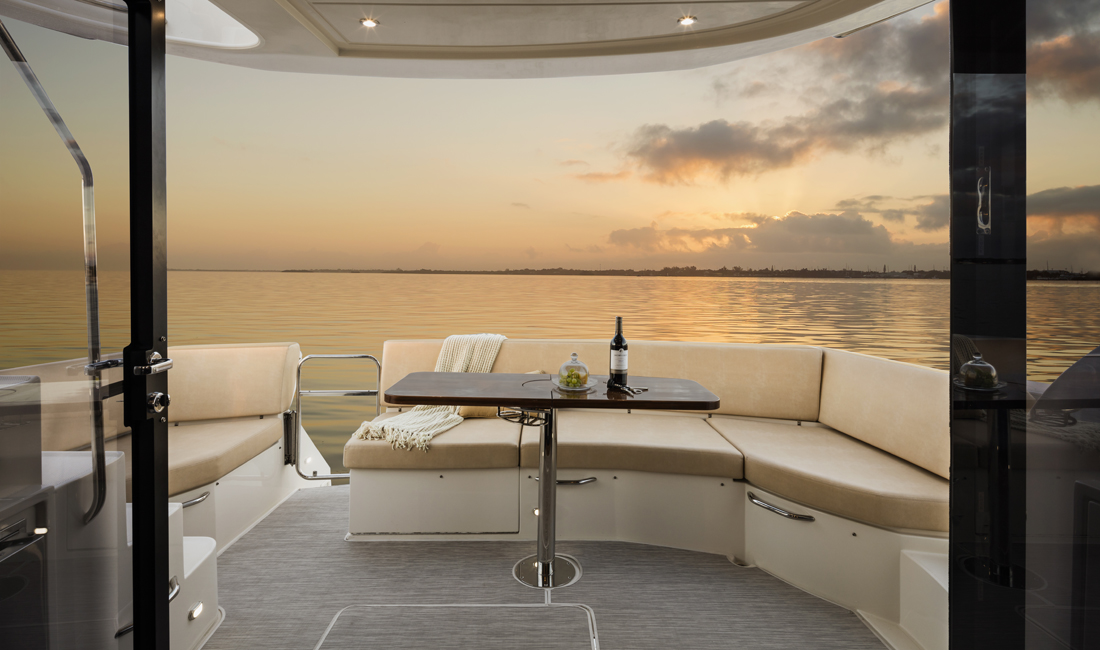
The full-width aft deck is well protected by the aft end of the flybridge, which in turn provides more room aloft for a seating area with table, a built-in locker for an optional open-air kitchen, and bench seating opposite the upper helm. Molded stairs to starboard and stainless steel handrails make it easy to move between the aft deck and the flybridge.
The added volume in the C52 extended to the engine room, which is nearly standup height, and has loads of room on both sides of each engine, as well as aft, where there’s remarkable access to the steering gear.
A three-panel, glass bulkhead opens wide to connect the aft deck with the galley portion of the saloon, which is all on one level. Positioning the galley aft makes great sense for connecting the chef with family and guests seated on the aft deck, as well as the dinette to port and the long lounge to starboard, up two steps forward. Interestingly, Carver offers a lower-helm option, which occupies the forward portion of the starboard lounge, but there’s still room left over for a love seat abaft it.
Optional wood plank soles on the yacht I tested lent a sophisticated, luxurious look to a saloon interior already well endowed with high-gloss furniture and cabinetry. And the nicely equipped galley had a couple of commendable options worth noting, including a Fisher-Paykel dishwasher and a second drawer-style NovaKool refrigerator/freezer, to help make longer cruises or entertaining a crowd more manageable.

A private spiral staircase leads to the full-beam master stateroom amidships, a feature not often found on 50-foot designs. The master is replete with touches of luxury and elegance, from the woven-look, wooden headboard of the island queen, pillow-top berth to the contemporary, frameless, glass enclosed shower with tile accent and teak seat.
The VIP stateroom in the bow includes many of the same luxury touches found throughout the master, including fixed hull windows.
Carver’s focus on the unique—from profile to running surfaces, from leading-edge construction to living areas to please both existing owners and the next generation, from satisfying and efficient performance to a well-equipped yet customizable platform—seems to be a leap forward. Given its 60-year heritage and willingness to innovate, Carver is a fine example of a company that has its sights set on the future.
The Info
Builder: Carver
Model: Carver C52 Command Bridge
Year: 2016
Boat Type: Cruiser
LOA: 51’10”
Beam: 15’8″
Draft: 4’0″
Standard Power: 2/480-hp Cummins QSC-6.7s
Base Price: $950,000
Optional Power: 2/600-hp Cummins QSC-8.3s; 2/715-hp Cummins QSC-8.3s
Test Engines: 2/600-hp Cummins QSC-8.3
Fuel Capacity: 550 gal.
Water Capacity: 150 gal.
Optional Equipment: NOTEWORTHY OPTIONS: Cummins Joystick ($31,845); air conditioning ($24,400); 23-kW Kohler genset ($43,730); flybridge Bimini w/ enclosure ($13,950); engine oil change system ($6,370); Raymarine autopilot ($8,360); flybridge grill ($2,600); washer/dryer ($3,595).
Price Tested: $1,211,485
GENERATOR: 13-kW Kohler
WARRANTY: 2-year stem-to-stern warranty protection for all Carver systems, components and workmanship; 5-year gelcoat blister warranty protection; and 10-year structural warranty protection for the hull and deck.
Denison exclusively represents Carver Yachts. For more information on the Carver C52 Command Bridge, contact 954.763.3971 or Sales@denisonyachtsales.com.






